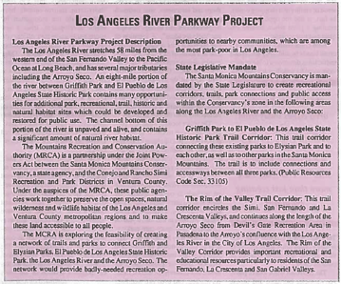The Los Angeles River is the site of various public agencies to rewild the natural wonder. Esther Feldman, Director of Speicla Programs for the Mountains Recreation and Conservation Authority (MCRCA), outlines the MRCA's Los Angeles River Parkway Project. Essentially, the Project will construct a park and recreation corridor between Griffith Park, Elysian Park and El Pueblo de Los Angeles State Historic Park.

"Development of parks, trails, staging areas, wildlife viewing areas and open space will provide nearby communities between Griffith Park and Elysian Park with safe and accessible recreation opportunities…"
The Los Angeles River, a corridor of parks, trails, view spots and wildlife habitat? Impossible, you say. Everyone knows the Los Angeles River is nothing more than a concrete ditch draining rainwater, and the urban wastes of at least eight million people over an area of 1,362 square miles. Well, take another look. One of the most promising efforts underway in Los Angeles today is the transformation of the Los Angeles River into an active and attractive recreational and trail corridor, connecting communities all along the length of the river.
One of the best-kept secrets in Los Angeles is that beautiful natural areas still thrive in the midst of our sprawling, busy metropolis of concrete, asphalt, buildings and traffic. Not only do they thrive: a wide range of homeowners, planners, environmentalists, civic leaders and elected officials continue to work together to permanently protect a growing network of park, wildlife, recreation and scenic lands throughout the county.
The Los Angeles River has received increasing attention in recent years for its wildlife habitat, recreational and trail corridor potential in the heart of urban Los Angeles. Numerous public agencies are actively working to plan and build these facilities, including the County of Los Angeles Department of Public Works, Parks and Recreation and Regional Planning, the City of Los Angeles Department of Transportation, the Mountains Recreation and Conservation Authority and many of the sixteen cities along the Los Angeles River's course.
Along the river's 51-mile length, parks and trails already exist in many places. People walk and ride bicycles daily along its banks. Great white egrets soar gracefully along the water, and ducks dive for food between willow-covered islands. And if you take the time to look, you will find that portions of this near forgotten river of ours is still a river, meandering within its banks, providing habitat for over 200 species of birds and a peaceful respite in the midst of one of the most heavily populated areas in Los Angeles County.
The Los Angeles River stretches 5 l miles from the confluence of Bell and Calabasas Creeks at the western end of the San Fernando Valley to the Pacific Ocean at Long Beach. The river's watershed includes over 470 miles of waterways and several major tributaries, including the Arroyo Seco and the Tujunga Wash. Following major flooding in the 1930's, the U.S. Army Corps of Engineers worked for nearly 20 years to channelize the Los Angeles River. Channelization straightened the river, reshaped the channel into the trapezoidal shape we see today and paved the banks and river bottom with concrete.
Twelve miles of the Los Angeles River remain unpaved on the channel bottom due to high water tables which precluded cementing the river bed. These unpaved areas contain a mixture of soft soil, boulders and cobble, which provide anchorage for a variety of plan habitat. These soft bottomed, vegetated stretches include 2.5 miles through the Sepulveda Basin, an eight-mile portion between Griffith Park and Elysian Park (called the Glendale Narrows), and a small area at Willow Avenue in Long Beach.
The Mountains Recreation and Conservation Authority (MRCA) is currently focusing its efforts on the live, soft-bottomed stretch of the Los Angeles River between Griffith Park and Elysian Park. This section of the Los Angeles River provides the best existing natural connection between Griffith Park and Elysian Park, as well as numerous potential recreational, park, historic, trail and natural habitat sites which can be further developed and restored for public use.
The MRCA is a local park agency consisting of the Santa Monica Mountains Conservancy and two local park and recreation districts. The MRCA's Los Angeles River Parkway Project carries out the Conservancy's state legislative mandate to provide a park and recreation corridor between Griffith Park, Elysian Park and El Pueblo de Los Angeles State Historic Park.
Working with a wide range of community organizations, elected officials and other public agencies, the MRCA hopes to develop a series of pocket parks and wildlife viewing areas along the river which will complement the city’s efforts to build a bicycle commuter trail and the county's overall Los Angeles River Master Plan.
The stretch of the Los Angeles River between Griffith and Elysian Parks provides most of the only green open space in one of the most densely-populated and heavily-developed areas in Los Angeles. With an average of only one acre of parkland per 1,000 residents, the communities surrounding the Los Angeles River in this area are among the most park-poor in the entire state. These communities, which include: Elysian Valley, Atwater Village, Cypress Park, Glassell Park, Highland Park, Lincoln Heights and Silverlake/Echo Park, lag far behind the national standard established by the National Recreation and Park Association of six to ten acres of community and neighborhood parks per 1,000 residents.
In addition to providing badly needed park and recreation opportunities, the Glendale Narrows stretch of the Los Angeles River provides a nearly year-round source of essential plant cover, forage and in-stream food source for both resident and migratory birds. A study recently conducted by the Natural History Museum of Los Angeles County found that the live stretches of the river provide important habitat for over 200 species of birds, 19 species of reptiles and amphibians and 9 varieties of freshwater algae. Approximately 102 of the bird species sighted are native to California.
In Los Angeles County, there has been a severe loss of lowland riparian habitat due to urbanization and development and the widespread practice of complete channelization of rivers and streams. The live, softbottom sections of the Los Angeles River provide an unparalleled opportunity to enhance existing wildlife habitat in the middle of a very urbanized area and to aid in providing vital linkages between these remnants of riparian habitat and other park, open space and habitat areas. Development of parks, trails, jogging areas, wildlife viewing areas and open space will provide nearby communities between Griffith Park and Elysian Park
with safe and accessible recreation opportunities, as well as natural resource education opportunities in the heart of urban Los Angeles. Students could learn first-hand about river functions, wildlife, necessary habitat and the river's role in a watershed connecting the mountains and the ocean.
In recent years, many other cities across the United States, including San Antonio, Denver, Chicago and Portland, have worked to transform their urban rivers into recreational corridors and centers for improved economic and tourist development. These river revitalization projects have been extremely successful in bringing urban river resources back to life.
It is truly unfortunate that we did not set aside enough open space in Los Angeles for parks, recreation and natural lands when there was plenty of it and land was cheap. Other major urban areas in the United States did, and are more livable because of their large and beautiful park and open space areas. Who can go to San Francisco without hearing about Golden Gate Park, or visit New York and not notice Central Park?
We have a chance, now, to transform the last large stretch of open space in Los Angeles into a world-class urban parkway. The Los Angeles River Parkway will be an urban park, trail and recreational corridor, serving all of us who live, work and play in the heart of metropolitan Los Angeles. Perhaps one day soon, you too will be able to walk or ride along the Los Angeles River and, next to the trains and buildings and between the concrete banks, you may see a Great Blue Heron soaring in search of a meal, and be soothed by the sound of the river on its way to the sea.
- Log in to post comments




